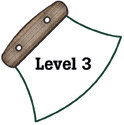|
National Science Education Standards
The motion of an object can be described by its position, direction of
motion, and speed. That motion can be measured and represented on a graph.
(Page 154)
The Earth is the third planet from the sun in a system that includes
the moon, the sun, eight other planets and their moons, and smaller objects,
such as asteroids and comets. The sun, an average star, is the central
and largest body in the solar system. (Page 160)
Most objects in the solar system are in regular and predictable motion.
Those motions explain such phenomena as the day, the year, phases of the
moon, and eclipses. (Page 160)
|
|
Benchmarks
The sun is a medium-sized star located near the edge of a disk-shaped
galaxy of stars, part of which can be seen as a glowing band of light
that spans the sky on a very clear night. The universe contains many billions
of galaxies, and each galaxy contains many billions of stars. To the naked
eye, even the closest of these galaxies is no more than a dim, fuzzy spot.
(Page 64)
The sun is many thousands of times closer to the Earth than any other
star. Light from the sun takes a few minutes to reach the Earth, but light
from the next nearest star takes a few years to arrive. The trip to that
star would take the fastest rocket thousands of years. Some distant galaxies
are so far away that their light takes several billion years to reach
the Earth. People on Earth, therefore, see them as they were that long
ago in the past. (Page 64)
Nine planets of very different size, composition, and surface features
move around the sun in nearly circular orbits. Some planets have a great
variety of moons and even flat rings of rock and ice particles orbiting
around them. Some of these planets and moons show evidence of geologic
activity. The Earth is orbited by one moon, many artificial satellites,
and debris. (Page 64)
Large numbers of chunks of rock orbit the sun. Some of those that the
Earth meets in its yearly orbit around the sun glow and disintegrate from
friction as they plunge through the atmosphere and sometimes impact the
ground. Other chunks of rocks mixed with ice have long, off-center orbits
that carry them close to the sun, where the sun’s radiation (of light
and particles) boils off frozen material from their surfaces and pushes
it into a long, illuminated tail. (Page 64)
We live on a relatively small planet, the third from the sun in the
only system of planets definitely known to exist (although other, similar
systems may be discovered in the universe). (Page 68)
Models are often used to think about processes that happen too slowly,
too quickly, or on too small a scale to observe directly, or that are
too vast to be changed deliberately, or that are potentially dangerous.
(Page 269)
|

